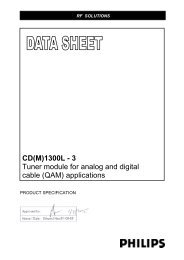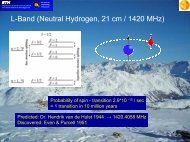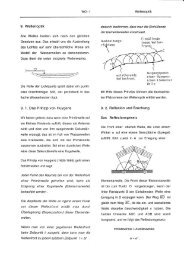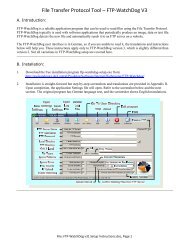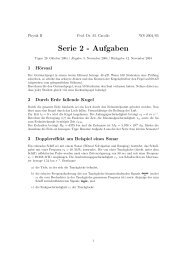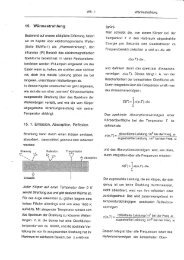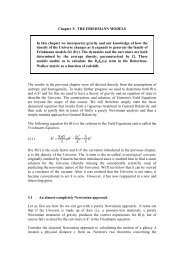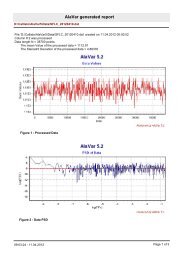here - Institute for Astronomy Umleitung
here - Institute for Astronomy Umleitung
here - Institute for Astronomy Umleitung
You also want an ePaper? Increase the reach of your titles
YUMPU automatically turns print PDFs into web optimized ePapers that Google loves.
Title: Science Case<br />
Reference: MUSE-MEM-SCI-052<br />
Issue: 1.3<br />
Date: 04/02/2004<br />
Page: 42/100<br />
lower metallicities, <strong>for</strong> truly primordial objects, the HeII 1640 line is favoured relative to Ly α<br />
(see Figure 2-21); <strong>for</strong> some assumed IMF, the HeII 1640 line luminosity could reach 4.10 41<br />
erg.s -1 at zero metallicity, corresponding to a flux of 3.10 -18 erg.s -1 .cm -2 , at z=5. Such a line<br />
would be easily detectable in the MUSE deep field. Finally, the MUSE ultra deep field<br />
described in section 6 (using gravitational amplification by a factor 3 in average), with its<br />
enhanced detection limit of 8.10 -20 erg.s -1 .cm -2 , should be able to detect simultaneously Ly α<br />
and HeII lines in the 2.8-4.7 redshift range <strong>for</strong> a metallicity lower than 10 -5 solar.<br />
Based on the models of Scanapieco et al (2003), the fraction of Ly α emitters that are Pop III<br />
objects could under certain scenarios be as high as 10% at z ~ 5 and L Lyα ~ 10 43 erg s -1 cm -2 .<br />
The point is that this is highly model dependent, and the detection of such objects (which is<br />
quite plausible) would greatly add to our understanding of the early chemical enrichment of<br />
the Universe.<br />
References<br />
Scanapieco, E., Schneider, R., Ferrara, A., astro-ph/0301628.<br />
Schaerer, D., 2002, A&A, 382, 28<br />
Schaerer, D., 2003, A&A, 397, 527<br />
Tumlinson, J., Giroux, M.L., Shull, J.M., 2001, ApJ, 550, L1<br />
Tumlinson, J., Shull, J. M., Venkatesan, A.: 2003, ApJ, 584, 608<br />
2.10. Active galactic nuclei at intermediate and high redshifts<br />
In a dramatic change of paradigm over the last years, active galactic nuclei (AGN) have<br />
altered their status from interesting but somewhat exotic objects into fundamental components<br />
of galaxy <strong>for</strong>mation and evolution. This change was mainly triggered by the recognition that<br />
supermassive black hole (SMBHs) are ubiquitous in massive galaxies (Magorrian et al 1998).<br />
The striking near-equality between the local black hole mass density and the total density of<br />
matter accumulated through accretion in AGN (Yu & Tremaine 2002) suggests that periods of<br />
nuclear activity may in fact be common phases within galaxy evolution. An intricate link<br />
exists between black hole growth, the <strong>for</strong>mation of galaxy bulges, and nuclear activity cycles;<br />
but most details are still missing from this picture.<br />
This is a challenge to theory and observers alike. In particular, the host galaxy and<br />
environmental properties of AGN at redshifts around and beyond z~1 will allow one to set<br />
strong constraints on <strong>for</strong>mation scenarios. This is an area w<strong>here</strong> MUSE will provide<br />
significant progress, because of its capability to reach very faint flux levels at good spectral<br />
resolution, combined with a high multiplex factor over an astrophysically relevant field size<br />
of ~ 250 kpc. A fundamental advantage of MUSE over existing or other planned instruments<br />
is the integration of the traditional multi-stepped approach of imaging, low-resolution and<br />
high-resolution spectroscopy into a single observation.




